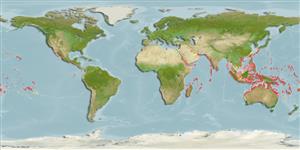>
Eupercaria/misc (Various families in series Eupercaria) >
Scaridae (Parrotfishes) > Scarinae
Etymology: Scarus: Greek, skaros = a fish described by anciente writers as a parrot fish; 1601 (Ref. 45335).
More on author: Lacepède.
Environment: milieu / climate zone / profondeur / distribution range
Écologie
marin récifal; profondeur 0 - 25 m (Ref. 90102). Tropical; 32°N - 32°S
Indo-Pacific: Red Sea to the Line and Ducie islands, north to southern Japan, south to Shark Bay, Western Australia and Lord Howe and Rapa islands. Absent from the Hawaiian Islands (Ref. 5439).
Length at first maturity / Taille / Poids / Âge
Maturité: Lm ?, range 17 - ? cm
Max length : 47.0 cm TL mâle / non sexé; (Ref. 2334); âge max. reporté: 20 années (Ref. 13619)
Description synthétique
Clés d'identification | Morphologie | Morphométrie
Épines dorsales (Total) : 9; Rayons mous dorsaux (Total) : 10; Épines anales: 3; Rayons mous anaux: 9.
Body shape (shape guide): fusiform / normal; Cross section: compressed.
Usually found on exposed outer reefs, sometimes in very shallow water (Ref. 2334). Juveniles occur among coral and rubble of lagoon reefs. Grazes on benthic algae (Ref. 30573). Generally solitary (Ref. 1602). Often in schools of mixed species when feeding (Ref. 48636). Minimum depth reported taken from Ref. 128797.
Life cycle and mating behavior
Maturité | Reproduction | Frai | Œufs | Fécondité | Larves
Oviparous, distinct pairing during breeding (Ref. 205).
Parenti, P. and J.E. Randall, 2000. An annotated checklist of the species of the labroid fish families Labridae and Scaridae. Ichthyol. Bull. J.L.B. Smith Inst. Ichthyol. (68):1-97. (Ref. 35918)
Statut dans la liste rouge de l'IUCN (Ref. 130435: Version 2025-1)
Menace pour l'homme
Harmless
Utilisations par l'homme
Pêcheries: commercial; Aquarium: Commercial
Outils
Articles particuliers
Télécharger en XML
Sources Internet
Estimates based on models
Preferred temperature (Réf.
123201): 24.7 - 29.3, mean 28.2 °C (based on 3162 cells).
Phylogenetic diversity index (Réf.
82804): PD
50 = 0.5000 [Uniqueness, from 0.5 = low to 2.0 = high].
Bayesian length-weight: a=0.01738 (0.01072 - 0.02817), b=3.07 (2.94 - 3.20), in cm total length, based on LWR estimates for this species & Genus-body shape (Ref.
93245).
Niveau trophique (Réf.
69278): 2.0 ±0.00 se; based on food items.
Résilience (Réf.
120179): Milieu, temps minimum de doublement de population : 1,4 à 4,4 années (K=0.45; tmax=20).
Fishing Vulnerability (Ref.
59153): Low vulnerability (23 of 100).
🛈
Nutrients (Ref.
124155): Calcium = 40.8 [26.4, 70.7] mg/100g; Iron = 0.815 [0.574, 1.232] mg/100g; Protein = 18.7 [16.7, 20.5] %; Omega3 = 0.0868 [, ] g/100g; Selenium = 21.1 [13.5, 32.6] μg/100g; VitaminA = 35.7 [10.9, 122.2] μg/100g; Zinc = 2.15 [1.62, 2.78] mg/100g (wet weight);
